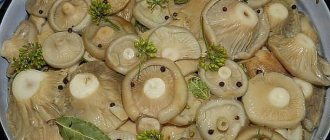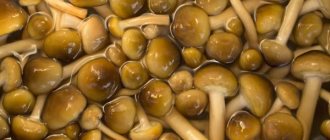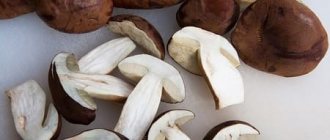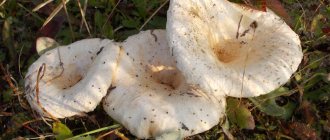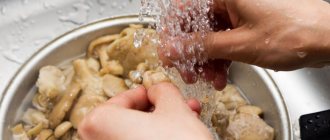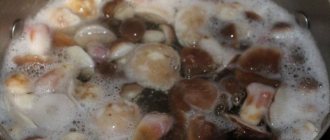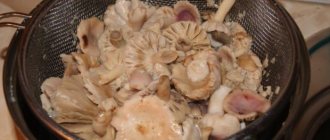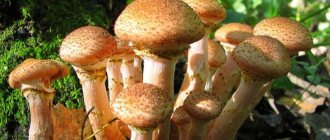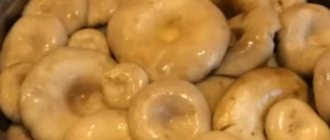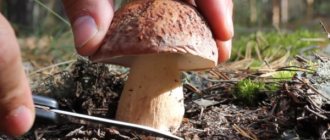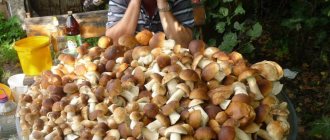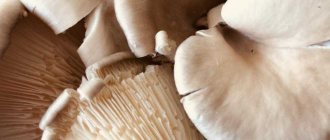Mushrooms
1
1570
Article rating
Kira Stoletova
Milk mushrooms are widespread edible mushrooms in Russia; they are popular in home canning in a number of regions. There are several varieties: white and black, creaking and pepper milk mushrooms, poplar milk mushrooms, yellow and many other types. However, most of them have a bitter taste, which, on the one hand, repels worms, but on the other hand, can be harmful to humans. Therefore, the main stage in preparation is soaking the milk mushrooms. We will tell you about important nuances, recipes and useful tips below.
Proper soaking of milk mushrooms
Is it necessary to soak milk mushrooms?
Milk mushrooms are classified as edible and conditionally edible mushrooms. In Russia they are classified in category I of nutritional value. The pulp of the mushroom contains a large amount of milky juice. It can be seen if you break the cap or leg of a milk mushroom. Interacting with oxygen, the milky juice oxidizes and acquires a greenish tint.
It is this substance that gives milk mushrooms their bitterness. You can get rid of it only by soaking. After this procedure, the mushroom is sent for processing. It is absolutely safe for human health, since there are no toxins in the chemical composition of milk mushrooms.
Result:
As a result, it must be said that the most important thing when collecting mushrooms, including milk mushrooms, is to know what mushrooms to collect, what to do with them, how to process them. You can read as much as you like about all these wisdom in books and on the Internet, but this is just help. The main work is wandering through the forest, collecting, doubtfully examining every mushroom found. Over time, experience comes, and the worries associated with collecting, cleaning, and soaking turn into annoying, but very pleasant chores.
How to properly clean milk mushrooms?
After the mushrooms have been collected, they must be filled with water and left in this state for 20 minutes. This is the very first soaking, without which you cannot move on to the next stage. The mushrooms will soften in the liquid, and it will be easy to remove dirt from them.
In 20 minutes. The water is drained and each mushroom is checked. Rotten specimens containing worms or their larvae are thrown away. Remove the surface film from good mushrooms. It can be easily removed with a knife.
The photo shows how to prepare and soak milk mushrooms.
If the mushrooms are old (they can be easily identified by their large size), then the spore-bearing plates must also be removed. They are located on the inside of the cap. The procedure begins with trimming the outer thin edge. It is most often wrapped inside the cap. White plates are removed using a knife. Movement: point from leg to edge.
A small life hack from experienced mushroom pickers - you can use a teaspoon or any other suitable size for these purposes. After cleaning, the mushrooms are rinsed with water.
Soaking milk mushrooms begins after these procedures. Only then, upon completion of this stage, the mushrooms must be cleaned again. After water procedures they are carefully examined. All places where rot is noticeable or there is a suspicion of it must be removed.
After this, use a toothbrush or sponge with hard bristles. Using a tool, clean the entire surface of the mushrooms. The milk mushrooms should turn white. There is a variety with a black color. Mucus is additionally removed from representatives of this species.
It spoils the taste of the dish, so it also needs to be removed. However, it will not be possible to achieve a white color when cleaning. Black milk mushrooms do not produce dark pigment. However, it does not pose any danger to human health.
What to do if a smell appears when soaking milk mushrooms
When soaked, milkweed can turn sour, resulting in a smell reminiscent of sauerkraut. The reason lies in the rare change of water or high room temperature. If the smell is strong and abundant foam appears, then it is better not to risk it and throw it away. Otherwise, you may get poisoned.
When an unpleasant odor has just begun to appear, and the liquid has been changed almost without delay, then it is possible to save the mushrooms. If you no longer need to soak them, you should first rinse them and then salt them using the chosen method. Make the saline solution strong. If further soaking is required, then rinse the raw materials, add fresh water and observe. If the smell reappears or gets stronger, throw out the milkweeds.
In what bowl should you soak milk mushrooms?
The dishes for soaking mushrooms are selected following the following recommendations:
- Enamel dishes are chosen intact, without cracking.
- Safe containers include products made of wood and glass. Enameled cookware is also harmless.
- The volume of the dish should accommodate not only all the mushrooms, but also an object that acts as a pressure.
- To avoid a chemical reaction and spoilage of the product, you should refuse aluminum cookware.
- When soaking with salt, do not use plastic products. Otherwise, there is a risk of releasing toxins.
You can use the soaking method, which was used before the invention of enamel cookware. The mushrooms were placed in an oak barrel. The wood gave milk mushrooms an unusual, pleasant aroma. You can purchase an oak barrel of any size. Even small containers suitable for home use are sold.
Distribution and collection features
The distribution areas of milk mushrooms are deciduous or mixed forests: birch, birch-pine, with linden undergrowth. The comfortable soil temperature required for their growth and reproduction is from +8 to +11°C. Therefore, they are practically not found in the south of Russia and Europe, preferring the northern regions of the temperate climate zone.
Milk mushrooms grow in July - September. If the weather is warm and rainy, they can occur in early October. They don’t like heavy rains; mushrooms quickly deteriorate after it. They also do not like long dry weather, but appear after a long drizzling “mushroom” rain. Milk mushrooms grow in large groups. If one mushroom is found, a whole family of them is sure to nest somewhere nearby, camouflaged by a dense cover of fallen leaves or pine needles.
Adult milk mushrooms can reach enormous sizes. The cap, with a diameter of 5 to 20 cm, looks like a funnel on top and has a wet surface. The stem is cylindrical, smooth, its height is up to 8 cm, its diameter is up to 5 cm. The color of the cap depends on the type of mushroom. It can be yellow, white and even black. When broken, it releases a caustic white juice, which, when exposed to air, quickly acquires a sulfur-yellow color. At the bottom, the cap consists of white wide plates.
We recommend reading: How to Preserve Beets for the Winter in a Warm Cellar
Not all milk mushrooms are edible. Particularly dangerous is the camphor milk mushroom, or camphor milkweed, which can cause severe poisoning if it accidentally ends up in a basket. Its special characteristics: a brown cap with sparse yellow plates, the place where it breaks immediately darkens. But, fortunately, it is rare.
Features of soaking
You need to soak milk mushrooms correctly. This will reduce the risk of poisoning. In addition, the soaking procedure will remove the milky juice, which spoils the taste of this mushroom.
There are recommendations that you are advised to follow when soaking milk mushrooms:
- All mushrooms must be under water. Otherwise, the milk mushroom pulp will come into contact with air, and an oxidation reaction will begin. This will cause the mushrooms to change color. If such an oversight does occur, then the milk mushrooms are removed, washed again, and the container is cleaned. The product is added again for soaking. To prevent the mushrooms from floating, you can put pressure on top.
- You can use a sieve as a pressure. It is immersed in a container on top of the mushrooms, and some kind of weight is placed in the middle. Glass plates or lids are often used.
- When soaking milk mushrooms, the water must be changed regularly. When mushrooms are in liquid, the same milky juice that gives bitterness comes out of them. Therefore, the water is drained at certain intervals. If this is not done, the liquid turns sour and the product spoils.
Soaking starts the fermentation process.
Why do milk mushrooms turn black when soaked?
Mushrooms turn black when cut. This is due to the content of milky juice, which upon contact with air turns gray-yellow and then black. This happens if you soak milk mushrooms in insufficient water. It must cover the raw material completely.
Another possible reason for the blackening of milkweeds is exposure to sunlight. Soaked raw materials should be kept covered or in a dark place.
Blackening is not a reason to throw away mushrooms. They need to be washed, immersed in cold water and kept under load for several hours. It is recommended to use raw materials for hot salting.
Advice! To prevent the lacticaria from starting to darken even at the cleaning stage, each processed specimen must be immediately placed in water.
How long to soak milk mushrooms?
You can soak milk mushrooms in different ways. This is influenced not only by the further method of salting, but also by the type of mushroom. There is a difference between white and black milk mushrooms. This feature is also important to take into account, since the difference affects the taste.
| Method of use | Deadlines |
| Before eating |
The water is salted. For 1 liter of water use 10 g of salt. Change the fluid 2 times a day. This way, you will be able to get rid of toxic substances. This is important for those mushrooms that were collected in places with poor ecology. |
| Cold brining method | Soaking time for mushrooms in cold water:
After soaking, start salting. |
| Hot salting method |
After soaking, the mushrooms are sent for heat treatment. |
| Before marinade | White milk mushrooms are used for pickling. Soaking takes no more than 1 day. The squeaky milk mushroom looks like this mushroom. It also has a characteristic white color. It differs only in the squeak that appears from the movement of the nail over the cap. If you break the pulp, a white liquid will appear on the surface. This mushroom is the most bitter of the entire milk mushroom family. Soak it for 4 or more days. |
After soaking, any type of milk mushrooms needs to be rinsed under running water.
Cold salting
The following types of milk mushrooms are suitable for pickling:
- black;
- white or real;
- yellow;
- oak;
- aspen;
- white and black loading pads.
To pickle these mushrooms in a cold way, you need:
- Place a layer of salt on the bottom of the dish.
- Cover it with blackcurrant, cherry leaves, dill stems.
- Lay the mushrooms in layers with their caps down, sprinkling them with salt, pepper, bay leaf, garlic, and horseradish leaves. The amount of salt must be calculated based on the proportion: 50 g per 1 kg of mushrooms.
- Cover with leaves.
- Place a lid on top that has a smaller diameter than the container.
- Press down with pressure.
The pickles will be ready for consumption after 1–2 months. It must be stored at a temperature of +5…+6°C. The basement and refrigerator are good for storage.
Important! You should be careful when consuming milk mushrooms, as they can overload the gastrointestinal tract and cause nausea, vomiting, diarrhea, and abdominal pain.
Milk mushrooms require soaking for several hours or days before salting. Despite the mediocre taste and pungency of fresh mushrooms, when salted they are very tasty and dense.
How to soak milk mushrooms correctly
You can soak milk mushrooms in apartment conditions. For this procedure you will need items that are in everyday use of most housewives. Choose the method that is least expensive and convenient.
Traditional soaking method
The mushrooms, cleared of dirt, are washed and placed in a container prepared for soaking. Pour clean fresh water so that it covers the entire product completely. If only the caps are soaked, they may float. To prevent the milk mushrooms from being on the surface, oppression is placed on top.
Leave the mushrooms to soak for 10 hours to 3 days (depending on the type of milk mushrooms). Every 4 hours the water is drained and new water is added. After 3-4 rinses, add salt to a new portion of liquid. Proportion: 1 tablespoon per 2 liters of water. Leave the mushrooms in this solution for 2 days. Salt water is changed 2 times a day. After the soaking period has expired, begin marinating or salting.
Soaking milk mushrooms for cold salting using the example of black milk mushrooms
This recipe is the traditional Russian northern method. This method appeared at a time when there were no electric or gas stoves, and all conservation was carried out using primitive methods.
The advantage of this method is that further salting after soaking does not require heat treatment. This is especially noticeable when a large number of mushrooms are subjected to the procedure, and not 3-5 kg.
Another advantage of this method: the body’s absorption of milk mushrooms prepared by this method is better. Even older people noted this fact. They ate mushrooms and did not experience any unpleasant consequences.
When processing black milk mushrooms, the fingers are painted a dark shade. You can get rid of it with citric acid. But in order not to injure the skin of your hands, you should use rubber gloves when peeling mushrooms.
Technology:
- Mushrooms are cut into large pieces. Wormy specimens are disposed of.
- Place the mushrooms in a container for soaking.
- Pour water so that it covers the milk mushrooms. You don't need a lot of liquid.
- The top of the mushrooms is covered with oppression. You can put a plate and a jar of water on it.
- Do not touch the mushrooms for 1 day. It is advisable to leave food containers at home. If the air temperature is +17°C or less, then the process will proceed slowly. Therefore, mushrooms are soaked in a warm place: +21…+25°C.
- After 24 hours, the mushrooms decrease in volume - this is a natural process. The milk mushrooms are taken out of the container and transferred to a plate. At this stage, you can notice that the color of the mushrooms began to change: from dark it acquired shades of red. A characteristic odor also appears. He's nice. The mushrooms should become more flexible to the touch.
- The water is poured out of the container in which the mushrooms were soaked. It is dirty, black or dark brown. Dishes are washed without chemicals. It is enough to wash away all the dirt.
- Milk mushrooms are placed in a washed container and filled with clean water.
- They put oppression on top.
- Leave to soak for 1 day.
- On the second day, the mushrooms may begin to sour (this is a natural process). Foam may appear on top of the water, indicating the start of fermentation. This is normal. Mushrooms are taken out of the water. They became lighter, the caps took on a reddish tint. The breasts also decrease in volume. The water is no longer as dirty as after the first soak.
- The container is washed and mushrooms are placed in it.
- Pour water so that it covers the mushrooms, but not in excess. Very little liquid is needed. It should only be enough for the milk mushrooms to be in it. If you pour too much water, the fermentation process will be disrupted.
- They put oppression on top.
- Leave for 1 day in a warm room.
- On the 3rd day, the mushrooms decrease in volume. They become elastic. The color of the caps became pronounced red, with a brown tint.
- Mushrooms are washed with clean water.
The readiness of mushrooms can be easily monitored by the color of the water. If after the third soaking it remains black and dirty, then the procedure should be repeated. The speed of the process is affected by the ambient temperature. In warm conditions, soaking will occur faster. You can find out if the mushrooms are ready using a taste test.
Milk mushrooms are soaked for at least 3 days before cold salting. Only after this proceed to the next stage. It is important to note that the soaking period should not take more than 7 days. Otherwise, the mushrooms will simply spoil.
Soaking white milk mushrooms
The mushrooms are washed. All dirt is removed from the caps and underneath them.
Then proceed in the following way:
- Place milk mushrooms into prepared dishes.
- Fill it with water and put pressure on top.
- Leave in this state at room temperature for 4-6 hours.
- Take the mushrooms out of the container.
- Wash the dishes and put the mushrooms back into them.
- Pour water into the container to cover the mushrooms.
- They put oppression on top.
The technology is repeated for 1-2 days. The mushrooms are left unchanged overnight and the water is not changed. After soaking, the readiness of the mushrooms is checked by a taste test.
Soaking after cooking
Sometimes mushrooms are heat-treated before soaking. To do this, cleaned milk mushrooms are placed in water and brought to a boil. After 10 minutes, remove from heat and cool. The mushrooms are washed under running water and placed in a salty solution for 1 week.
This method is only suitable when the mushrooms, after pickling, are transferred to sterilized jars. This treatment allows you to eat milk mushrooms after 1-1.5 months.
Video
We offer you to watch a video that tells about another recipe for salting white milk mushrooms:
About the author:
Anna Borovkova Freelancer with diverse interests and hobbies. Likes to be close to nature, eat delicious food and philosophize about the eternal. She has been writing articles on a variety of topics for so long that she is already erudite in the most unexpected areas. Loves forests, flowering gardens, space and fried potatoes with smoked ribs. He doesn’t like to stand at the stove, but among his friends there are several professional chefs who will always feed you delicious food and share cool recipes. Pathologically optimistic.
Found a mistake? Select the text with the mouse and click:
Ctrl + Enter
Did you know that: In small Denmark, any piece of land is a very expensive pleasure. Therefore, local gardeners have adapted to growing fresh vegetables in buckets, large bags, and foam boxes filled with a special earthen mixture. Such agrotechnical methods make it possible to obtain a harvest even at home.
Natural toxins are found in many plants; Those grown in gardens and vegetable gardens are no exception. Thus, the seeds of apples, apricots, and peaches contain hydrocyanic acid, and the tops and peels of unripe nightshades (potatoes, eggplants, tomatoes) contain solanine. But do not be afraid: their number is too small.
Convenient Android applications have been developed to help gardeners and gardeners. First of all, these are sowing (lunar, flower, etc.) calendars, thematic magazines, and collections of useful tips. With their help, you can choose a day favorable for planting each type of plant, determine the timing of their ripening and harvest on time.
Both humus and compost are rightfully the basis of organic farming. Their presence in the soil significantly increases the yield and improves the taste of vegetables and fruits. They are very similar in properties and appearance, but they should not be confused. Humus is rotted manure or bird droppings. Compost is rotted organic remains of various origins (spoiled food from the kitchen, tops, weeds, thin twigs). Humus is considered a higher quality fertilizer; compost is more accessible.
“Frost-resistant” varieties of garden strawberries (more often simply “strawberries”) need shelter just as much as ordinary varieties (especially in those regions where there are snowless winters or frosts alternating with thaws). All strawberries have superficial roots. This means that without shelter they freeze to death. Sellers’ assurances that strawberries are “frost-resistant,” “winter-hardy,” “tolerates frosts down to −35 ℃,” etc. are deception. Gardeners must remember that no one has yet managed to change the root system of strawberries.
One of the most convenient methods for preparing a harvest of vegetables, fruits and berries is freezing. Some believe that freezing causes the nutritional and health benefits of plant foods to be lost. As a result of the research, scientists have found that there is practically no decrease in nutritional value when frozen.
In Australia, scientists have begun experiments in cloning several varieties of grapes grown in cold regions. Climate warming, which is predicted for the next 50 years, will lead to their disappearance. Australian varieties have excellent characteristics for winemaking and are not susceptible to diseases common in Europe and America.
The homeland of pepper is America, but the main breeding work on developing sweet varieties was carried out, in particular, by Ferenc Horvath (Hungary) in the 20s. XX century in Europe, mainly in the Balkans. Pepper came to Russia from Bulgaria, which is why it received its usual name - “Bulgarian”.
A new product from American developers is the Tertill robot, which weeds weeds in the garden. The device was invented under the leadership of John Downes (creator of the robot vacuum cleaner) and works autonomously in all weather conditions, moving over uneven surfaces on wheels. At the same time, it cuts off all plants below 3 cm with the built-in trimmer.
Tips and tricks
Recommendations and tips that:
- To get rid of the smell of milk mushrooms on your hands, wipe them with sunflower oil and then wash it thoroughly with soap and water.
- To prevent the appearance of the mushroom from becoming deformed during cleaning, the knife is replaced with a brush.
- If the mushrooms are large, then they can be cut into slices. Thanks to this, all the bitterness from the milk mushrooms will come out faster.
- Iodized salt gives mushrooms an unpleasant taste. It is replaced with a regular kitchen one.
- The safest type of milk mushroom, in which the minimum amount of milky juice is present, is the white variety. In relation to the black type, it contains much less toxins. Therefore, in some cases, white milk mushrooms can be soaked for 10 to 15 hours.
- At your dacha or in a village house, you can try the old method of soaking mushrooms. The milk mushrooms were placed in a cloth bag, nettles were added to them and everything was lowered into the river. The reservoir must be clean. It is desirable that there be at least a slight current. If the reservoir is cold, then you will have to wait 5 days for the desired effect.
- In small mushrooms, the plates under the cap are not removed. However, it is still necessary to clean them from dirt. A toothbrush helps in this matter. The breast is placed under running water and they begin to “sweep” particles of dirt along the plates.
- After soaking the white mushrooms, the drained water should be a little dark, but transparent. This will indicate the correct completion of the process. In black-colored mushrooms, the liquid may remain dark all the time, no matter how many times you change it. This is due to the high content of coloring pigments in the black mushroom. After soaking the milk mushroom, the water turns reddish.
- You can check whether the mushroom has soaked well in a simple and safe way for humans. It is enough to take 1 specimen out of the water, break off a piece of it and try it. If there is no bitterness, then the process was successful. If there is an unpleasant aftertaste, soaking should be continued.
- To preserve the aroma of milk mushrooms, they are salted without using any spices. All you can do is salt. Only before serving, add fresh dill or garlic to the mushrooms.
- The most delicious preparations from milk mushrooms are obtained if the stem is removed from the mushrooms in advance and only the cap is used.
- If the milk mushrooms are bitter even after salting, then they are washed under running water and sent for another soaking. They are kept in liquid for 1-2 days and then salted again.
- In the forest, when collecting milk mushrooms, preference should be given to young mushrooms. They have not yet had time to accumulate a large amount of milky juice in the pulp, and therefore it will be easier to get rid of the bitterness.
- To ensure less bitterness in milk mushrooms, it is recommended to collect them after rain or in damp weather. In those specimens that have dried out in the sun, there is little moisture and a lot of milky juice. Because of this, the bitterness is more noticeable.
- In mushrooms that have been left untreated for a long time after being picked, it will be more difficult to remove the bitterness.
- If long-term soaking of mushrooms does not help to completely get rid of the bitter taste, then spices will drown it out: garlic, onions, vegetable oil.
Any milk mushrooms must be soaked before eating. This is the only way to give them a pleasant taste. Although this method takes a long time, it remains the most effective for many years. Some people pickle mushrooms without soaking. But in this case, the dish acquires a tart taste, which not all people like.
Preparing mushrooms
Mushrooms must be peeled before cooking.
Preparing milk mushrooms for boiling is a long and rather labor-intensive process. It includes:
- manually cleaning each specimen from visible lumps of earth, blades of grass, and other foreign particles (old and damaged mushrooms touched by worms are not suitable for pickling);
- soaking in cold water in a spacious container (basin, bathtub) for several hours (preferably for a day), and the water must be changed periodically;
- thoroughly washing each mushroom in clean water (some even recommend using a toothbrush for this purpose);
- removal of long legs;
- Large caps can (but not necessarily) be cut into slices.
If soaked for a long time, the milk mushrooms may darken. This usually happens because they are not completely submerged in water. Therefore, the mushrooms must be washed and soaked again in new water. But put a weight on top so that they are all under a layer of water.
Salted milk mushrooms - a classic recipe
There is another type of this valuable mushroom, distinguished by the acridity of its milky juice and an aroma vaguely reminiscent of fruity notes. In this recipe you will find a description of how to salt aspen milk mushrooms (poplar milk mushrooms).
Number of servings: 100
Cooking time: 1 hour 45 minutes
Ingredients
- poplar mushroom – 5 kg;
- blackcurrant leaf – 10 pcs.;
- horseradish, leaves – 2 pcs.;
- coarse salt – 150 g;
- dill with umbrellas – 4 pcs.;
- cherry leaf – 10 pcs.
Step-by-step preparation
- Soak the mushrooms for two to four days until they no longer taste bitter. Change the fluid at least once a day with a new one.
- Line the bottom of the container with a couple of cherry and currant leaves and a small amount of dill seeds. Place a thin layer of milk mushrooms on top, sprinkling with a tablespoon of salt and some more greens. Continue in this sequence until the entire volume is used up. Cover with gauze. Set the pressure. Try again after 40 days.
Whatever milk mushroom you find, you can always prepare a quick dish from it that serves as an excellent snack.
To do this, just add a spoonful of rich sour cream to the mushrooms when frying or stewing. Bon appetit! Did you like the recipe? Save it to your Pinterest! Hover over the image and click “Save.” Today in the section “Winter Preparations” there are recipes on how to pickle milk mushrooms.
This is a wonderful autumn mushroom, which makes a tasty, aromatic snack and is especially pleasant when the salted milk mushrooms turn out crispy.
You can salt them coldly, the so-called dry salting, or hot, using prepared brine; some recipes suggest boiling them first, but I prefer the old grandfather’s method.
Recipe with vinegar for iron lids at home
For the winter, we most often use iron lids. However, the jar is hermetically sealed and does not interact with air. After all, we know that as soon as a mushroom sticks out of the brine, it instantly becomes covered first with plaque and then with mold. We use vinegar as a preservative. In the recipe I will give the amount of essence and 9% vinegar.
Traditional composition:
- milk mushrooms – 2 kg,
- water – 2 liters,
- 50 g salt,
- 4 laurel leaves,
- 6 pieces of sweet peas,
- 6 clove inflorescences,
- 20 ml of vinegar essence 70% (240 ml of table vinegar 9%).
Pre-soak and clean the mushrooms.
Be sure to sterilize jars and lids.
Then dilute 10 g of salt in 1 liter of water (from the indicated ingredients) and boil the milk mushrooms in it. You need to cook them for so long until they sink to the bottom.
Be sure to remove the foam.
Then we rinse the fruits under running water.
Pour 1 liter of water into the pan again, add 40 g of salt and, if you want, sugar, the rest of the spices and boil.
Place milk mushrooms and cook for 10 minutes. Add vinegar and cook for another 10 minutes.
Place the mushrooms in jars, pour boiling marinade over them and roll up the lids.
After 5 days, the jars can be put away in the pantry.
Preparing mushrooms for pickling
There are many recipes for preparing milk mushrooms, but the preparation process is the same for everyone. Its main task is to remove the bitterness contained in the milky juice secreted by the mushroom, and to clean the sticky caps from leaves and pine needles. It is not recommended to peel the skins from the caps and stems, like noble mushrooms. Armed with a household brush, simply remove debris under running water and wash off fungi.
Important! Mushrooms of the same type may require longer water procedures, so it is recommended to collect only young fungi. It’s better to take a longer walk in the forest and breathe clean air than to quickly collect “old people” with hard pulp and increased levels of toxins and bitterness.. Now all that remains is to put the washed mushrooms in a large enamel pan or basin and fill it completely with water
The crucial moment of preparatory work comes - soaking the bitterness. How long to soak - there is no unambiguous definition of timing. It all depends on the type of milk mushrooms. If it is enough to keep the white milk mushrooms in water for 3-4 days, then to soak the bitter milk mushrooms you will need at least 7 days of constantly changing the water and rinsing the fungi under running water
Now all that remains is to place the washed mushrooms in a large enamel pan or basin and completely fill it with water. The crucial moment of preparatory work comes - soaking the bitterness. How long to soak - there is no unambiguous definition of timing. It all depends on the type of milk mushrooms. If it is enough to keep the white milk mushrooms in water for 3-4 days, then to soak the bitter milk mushrooms you will need at least 7 days of constantly changing the water and rinsing the fungi under running water.
The main thing is that the milk mushrooms are completely immersed in water. To do this, you will need to place a suitable sized lid and a small weight in the basin. This could be a gymnastic weight or several packs of salt placed in a pan.
After soaking, the mushrooms are placed in a large basin, placed under the tap and each mushroom is thoroughly washed under running water. Now you can begin the main stage - salting or marinating mushrooms with a crispy crust.
For beginning mushroom pickers, it is important to know the minimum amount of salt for different harvesting methods. For salting, use only coarse salt
“Extra” or iodized salt is not used for capping.
The data is given taking into account the proportion of the amount of salt per kilogram of fungi:
- dry pickling of milk mushrooms – 40 grams;
- hot or cold – up to 60 grams;
- preparation of marinade - up to 60 grams.
Note to the owner! Don't worry if the milk mushrooms are too salty. Simply soaking a portion of milk mushrooms in milk will help correct the situation without loss of taste. After standing in it for 40-60 minutes, the mushrooms will become juicier and properly salted. Soaking in water is not recommended - together with salt, the rich taste of mushrooms is lost.
How to salt volushki for the winter using the hot method correctly: recipes and secrets
- If you don’t have a wooden barrel, and you can’t provide suitable conditions for pickling mushrooms, then you will have to give up the classic taste of mushrooms prepared according to “grandmother’s recipe.” However, there are many other ways to prepare trumpets for the winter.
- However, you can always find other options for preparing the dish you like. If we are talking about mushrooms, then you can cook them hot.
Popular articles Popular varieties of western thuja, planting and caring for them
You can try salting the volushki using a combined method.
Products:
- 5 kg of mushrooms
- 6 tablespoons salt (no heaping)
- 5 bay leaves and 5 currant leaves
- 2 leaves of horseradish
- fresh dill – about 5 g
- 2-3 cloves of garlic
- 2 liters of water
Cooking process:
- Pour the entire portion of water into a container for cooking on the stove. Add 2 heaped tablespoons of salt. We wait until the liquid boils.
- All further manipulations are carried out with pre-soaked mushrooms. Pour the mushrooms into boiling water and stir. Cook for 10 minutes, all this time removing the foam with a spoon.
- Using a colander, remove the mushrooms from boiling water and rinse under the tap.
- Throw the peeled and chopped garlic into large pieces or into two halves into a pan with the mushrooms laid in one layer (we divide the portion of garlic into two parts so that the second part is thrown on top). Pour salt and add washed greens.
- Place a second layer of mushrooms, sprinkle with salt again, add dill and the remaining garlic. Cover with a clean towel and apply pressure. We put the pan in the refrigerator. Within a month, the mushrooms will be pickled and ready to eat.
